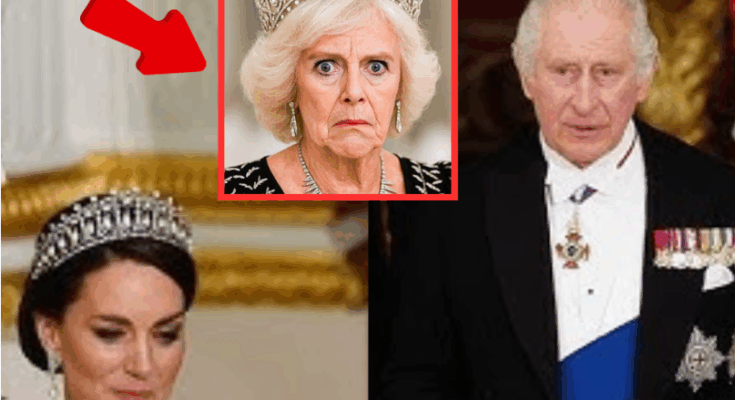In an unprecedented turn of events within the royal family, Queen Camilla’s name has been conspicuously removed from a historic royal decree signed by King Charles and Princess Anne, sending shockwaves through the palace and the public. The decree, which marks a significant reshaping of royal representation, has left many questioning the future role of Queen Camilla within the monarchy. Historically, Queen Consorts have been central figures in royal decrees, signifying continuity, stability, and the enduring power of the monarchy. However, in this latest move, Camilla’s absence was anything but accidental. Insiders at the palace have confirmed that her omission was a deliberate and strategic decision. The document, which outlines key responsibilities and defines the core members of the royal family, now exclusively lists King Charles,

Princess Anne, Prince William, and Princess Catherine. The decision to exclude Camilla from the royal decree has been interpreted by many as a monumental shift in the monarchy’s structure, signaling a reduction in her ceremonial power and influence. This shift is not merely symbolic; it is a move that directly impacts her role within the royal family and her ability to influence public and private matters of state. In the wake of this decision, royal observers have noted a growing influence of Princess Catherine, who is increasingly seen as a key figure in the future of the monarchy. Her power, once considered secondary to Camilla’s, is now gaining unprecedented recognition. Princess Catherine’s role is expanding beyond traditional ceremonial duties, with many experts speculating that she will be the one to lead the monarchy into its next chapter, particularly as the global spotlight continues to shine on her. The royal decree’s significance lies in the fact that it is not just a routine document; it represents the strategic direction of the monarchy in an era where public perception and accountability are paramount. As the royal family faces mounting pressure to modernize and adapt to the changing global landscape, this decision appears to signal that the monarchy is ready to prioritize efficiency and unity, possibly at the expense of figures like Camilla, whose role has long been a source of division and public scrutiny. For Queen Camilla, this exclusion is a significant blow, marking the culmination of months of quiet tensions behind palace walls. While she has remained a loyal partner to King Charles, her increased visibility and assertiveness in recent years have begun to clash with the monarchy’s desire for a streamlined and focused image. Sources close to the situation reveal that Princess Anne,

who has long been regarded as a steady and trusted figure in the royal family, played a key role in pushing for this shift. Anne’s approach to the monarchy has always been rooted in tradition and protocol, and her influence within the royal family has been steadily growing. While Camilla sought to carve out a larger role for herself, Anne has remained steadfast in her commitment to maintaining the core values of the monarchy, advocating for a more streamlined and focused royal family. As the royal family moves forward, Anne’s position as a central force behind King Charles’s reign has become increasingly clear. This shift in power dynamics has led to questions about the future of Camilla’s role. While she remains Queen Consort in title, her ability to influence royal affairs has been dramatically reduced. The exclusion from the royal decree is seen as a clear message: the future of the monarchy is now firmly in the hands of King Charles, Princess Anne, and the next generation represented by Prince William and Princess Catherine. Princess Catherine, who has long been admired for her grace, poise, and strong public presence, is now seen as the face of the modern monarchy. Her involvement in royal duties has grown steadily, and her influence on both national and international stages continues to expand. From diplomatic engagements to charitable initiatives, Catherine’s role as a leader within the royal family is becoming more pronounced, signaling her growing influence.
As Queen Camilla finds herself sidelined, questions are being raised about her future in the public eye. Although she remains married to King Charles and retains her title, her absence from this critical royal document raises doubts about her long-term role in the monarchy. Insiders suggest that this move is part of a broader effort to realign the monarchy with contemporary values, focusing on a core group of royals who can effectively represent the crown in an ever-changing world. For Princess Catherine, this shift represents both a responsibility and an opportunity.
As she increasingly takes on more duties and garners public support, her influence within the royal family is only set to grow. With the backing of King Charles and Princess Anne, Catherine is emerging as a central figure in the monarchy’s future, one who is capable of bridging tradition with modernity. As the royal family navigates this transition, it remains clear that a new era is dawning. The strategic decisions being made behind palace doors are shaping the monarchy for generations to come. With Princess Catherine poised to take on a larger role, and Queen Camilla’s influence quietly diminishing, the monarchy is preparing for a future where power is concentrated in the hands of a select few. The royal decree’s finality may have been a subtle move, but its impact is far-reaching. The monarchy’s landscape is evolving, and the era of Queen Camilla as a central figure appears to be coming to an end.



